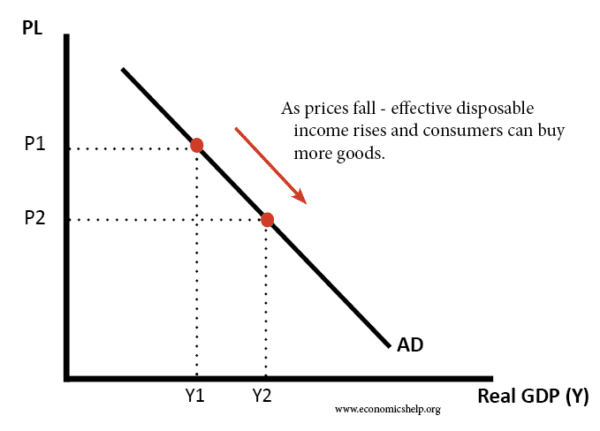The aggregate demand curve (AD) is the total demand in the economy for goods at different price levels. AD = C + I + G + X – M
If there is a fall in the price level, there is a movement along the AD curve because with goods cheaper – effectively, consumers have more spending power.
Why is AD curve downwardly sloping?
- Increased spending power. At a lower price level, consumers are likely to have higher disposable income and therefore spend more. (Note this assumes that wages are constant and not falling with prices)
- Increase in demand for exports. If there is a lower price level in the UK, UK goods will become relatively more competitive, leading to higher exports. Exports are a component of AD, and therefore AD will be higher.
- Lower interest rates. At a lower price level, interest rates usually fall, and this causes higher aggregate demand.
Difference with microeconomics
The rise in demand is not due to the usual microanalysis. In microeconomics when we examine one particular good, a lower price of a good leads to more demand because it is cheaper.If the price of potatoes falls, you may buy more potatoes instead of pasta because potatoes are now relatively cheaper. This is an example of a fall in the price of a particular good.
With aggregate demand (AD) we are looking at the aggregate price level for the whole economy.
Why lower prices may not increase AD
In macroeconomics, a period of (deflation) (falling prices) can cause a different dynamic which leads to lower spending.
- A period of deflation (falling prices) can often cause lower aggregate demand – especially if falling prices is accompanied with falling wages (or at least stagnant wages)
- If prices are falling, consumers may delay purchases because they expect prices to be cheaper in the future
- If prices (and wages) are falling, then consumers may see an increase in the real value of debt. Deflation increases the effective debt burden, leaving less for spending.
- Falling prices may increase real interest rates – if nominal interest rates can’t fall any further.
However, falling prices could be compatible with rising aggregate demand
If falling prices are due to technological improvements and enabling higher real wages. In this case, we could get lower prices, but AD continues to increase.
If falling prices are caused by a recession and spare capacity, then we are much more likely to get lower AD. In a recession, wage growth will be weak and consumers nervous to spend. Falling prices will be not sufficient to encourage spending because confidence is low.
Related


Hi I would like to know the reasons of downward sloping aggregate demand curve
wealth effect
interest rate effect
international effect
multiplier effect
Real balance effect
Rate of interest effect
Foreign trade effect